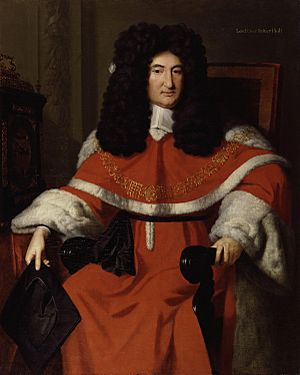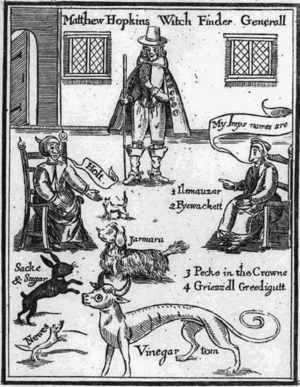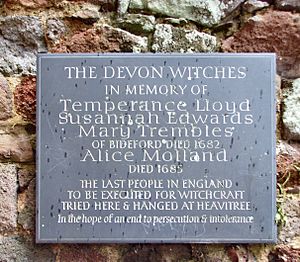Witch trials in England facts for kids
In England, special court cases called witch trials happened for a long time, from the 1400s to the 1700s. It's thought that about 500 people died because of these trials. Most of these people, about 90%, were women. The time when witch hunts were most common was during the English Civil War (1642–1651) and the Puritan period in the mid-1600s.
Contents
Understanding Witch Trials in England
When Witch Trials Happened
Witch trials did happen in England during the Middle Ages. But these cases were rare. They often involved important people or those connected to them. Sometimes, these trials had a political reason. For example, Eleanor Cobham and Margery Jourdemayne faced trials in 1441. Eleanor was imprisoned for life, and Margery was executed.
However, many more witch trials started in the late 1500s. They became even more common in the early 1600s. This was especially true after James VI and I became king. King James was very interested in witch trials. He had seen the Copenhagen witch trials in 1589. These trials inspired the North Berwick witch trials in Scotland in 1590. When he became King of England in 1603, he made the English Witchcraft Act stricter.
The most witch trials in England happened in the first half of the 1600s. They were at their peak during the English civil war in the 1640s. This time was also known for famous witch hunters like Matthew Hopkins.
Laws About Witchcraft
England had a law called the Witchcraft Act 1542. But it was removed in 1547. Then, the Witchcraft Act 1563 made it a crime punishable by death if someone used magic to cause another person's death. In 1604, the Witchcraft Act was changed again. It now included anyone who was believed to have made a deal with evil spirits.

How Witch Trials Worked
In England, people were not usually accused of attending a "Witches' Sabbath" or making a deal with evil spirits. Instead, the typical person accused was often a poor, older woman. She usually had a bad reputation. Her neighbors would accuse her of having a familiar (a spirit helper) or of harming people's animals using magic.
Around 500 people are thought to have been executed for witchcraft in England.
Usually, people found guilty of witchcraft in England were executed by hanging. But there were some exceptions. If a person had also committed another serious crime, they might face a different punishment. For example, Mary Lakeland was burned in Ipswich in 1645. She was not burned just for witchcraft. She was burned because she was accused of using witchcraft to cause her husband's death. This was seen as a very serious crime. Similarly, Margaret Read was burned in King's Lynn in 1590. Mary Oliver was burned in Norwich in 1659.
Politics and Religion in Trials
Historian John Callow wrote in his 2022 book, The Last Witches of England, that politics and religion played a role. He says that trials were affected by tension between certain Protestant groups (called nonconformist Whigs) and followers of the Anglican church (called Tories). This happened after the English Civil War.
Ending Witchcraft Prosecutions
The Bideford witch trial in 1682 led to the last confirmed executions for witchcraft in England. However, the very last person executed was probably Mary Hicks in 1716. Her story was written down in a pamphlet that same year.
Jane Wenham (who died in 1730) was one of the last people sentenced to death for witchcraft. But her conviction was later overturned. Her trial in 1712 is often mistakenly called the very last witch trial in England.
The Witchcraft Act 1735 finally stopped all legal actions for alleged witchcraft in England. This happened after many judges, especially Sir John Holt (1642–1710), had already started to question and stop convictions of alleged witches.
Witch Trials in English Colonies
Witch trials also happened in the English colonies. This is because English law was used there. This was especially true in the Thirteen Colonies in North America. Examples include the Connecticut Witch Trials from 1647 to 1663. The most famous of these trials were the Salem witch trials in 1692. In 1683, two women were found not guilty of witchcraft in Province of Pennsylvania. Their trial happened in Philadelphia before William Penn.
See also
- Channel Islands Witch Trials
- Witch trials in Scotland
- Witch trials in the early modern period



